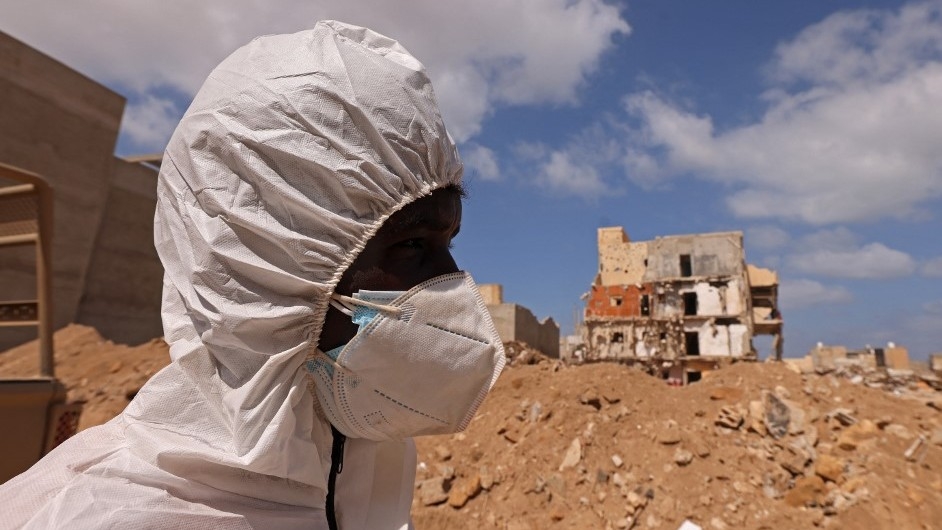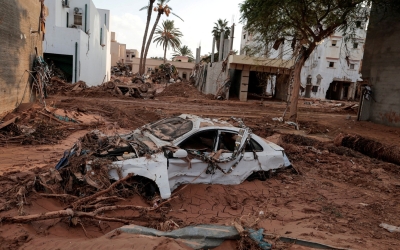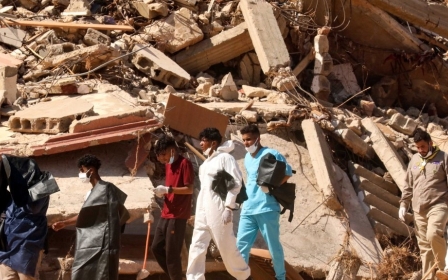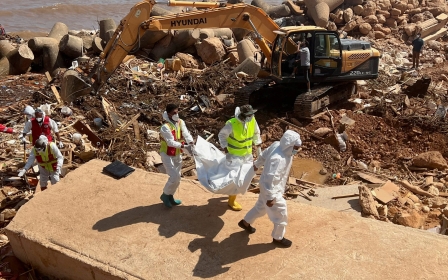Libya floods: Campaigners fear for 'un-trackable' refugees

Hundreds of refugees are feared dead in the aftermath of Storm Daniel in Libya as many of them have become "untrackable", rights groups warned on Monday.
According to the Libyan Red Crescent, at least 11,300 people have died and more than 10,000 have gone missing after Storm Daniel tore through eastern Libya on 11 September.
Over 1,000 refugees and migrants registered with UNHCR were resident in the east of Libya prior to the floods, including the areas affected by Storm Daniel, according to the UN agency.
Split between rival administrations in the east and west of the country, Libya is home to an estimated 625,638 refugees and migrants. Eastern Libya is a key transit point for migrants attempting to cross the central Mediterranean to Europe.
The collapse of the two Wadi dams on the outskirts of the eastern city of Derna saw entire neighbourhoods swept into the sea.
The resulting devastating floods engulfed 900 buildings in the city, unleashing a humanitarian crisis, and displacing over 40,000 people according to the International Organisation for Migration (IOM), with aid struggling to reach survivors suffering from medicine shortages and contaminated water.
According to UNCHR a further 46,000 internally displaced people (IDPs) were residing in the east of Libya at the time of the floods, including 34,000 in Benghazi, 3,100 in Ajdabiya, and 2,800 in Derna, the most affected area.
Another 2,400 IDPs were hosted in the Green Mountain region, 420 in Almarj, and approximately 1,450 in Tobruk.
'Whether it's migrant workers who entered the country irregularly or people who are on the move, who are in Libya only for transit, they're extremely hard to track'
- Hanan Salah, HRW
"The floods caused mass displacement, adding to the number of people who were already displaced before Storm Daniel hit the country," UNCHR Head of News and Media, Chris Saltmarsh told Middle East Eye. "However, estimates of flood-induced population displacement are not available yet."
On Tuesday, the Libyan authorities confirmed the deaths of 145 Egyptian nationals, 74 of them migrant workers from the same village in the Beni Suef governorate.
Meanwhile, the war monitoring group, the Syrian Observatory for Human Rights reported that 42 Syrians have been confirmed dead in Libya, although the real number could exceed 150.
“The question is, are they the only ones or are there bigger groups of migrant workers who were affected?” Human Rights Watch researcher, Hanan Salah told MEE.
Human rights groups have expressed concern about the lack of efforts by authorities to trace the refugees and asylum seekers in the affected areas.
“I have not seen that there has been an effort to proactively track or look for people who could be held with the known hubs for smugglers,” she told MEE. “If somebody is there in transit, people become basically untrackable.”
“Whether it's migrant workers who entered the country irregularly or people who are on the move, who are in Libya only for transit, they're extremely hard to track,” she said.
Creating a fortress
Human rights campaigners have long documented abuses of refugees and migrants in Libya, who have suffered arbitrary detention and torture at the hands of militias and smuggling networks, many of them affiliated with General Khalifa Haftar, who dominates eastern Libya.
A report by Der Spiegel revealed that the smugglers who coordinated the deadly Pylos shipwreck in June had close ties to Haftar.
In a briefing to EU officials, UNCHR and the IOM described these smuggling operations as “lucrative source of income for the eastern Libyan rulers involved”.
Despite this, Haftar is being courted by EU member states in a bid to curb the influx of migrants arriving on European shores.
Italy has funnelled funding and equipment to bolster the Libyan Coast Guard via a Memorandum of Understanding, which was renewed in February this year.
According to Medicins Sans Frontieres: “The agreement between Italy and Libya supports the system of exploitation, extortion, and abuse in which so many migrants find themselves trapped.”
According to a Statewatch report, for the period 2021-2027, the EU will spend an "unprecedented" amount of public money for security and defence purposes, with development aid being redirected towards border management.
For many human rights defenders, the disparity between the well-resourced Libyan coast guard, and the funding-starved infrastructure that amplified the destruction wrought by the floods, is stark.
“The European Union has been focusing on ensuring that irregular migration into Europe is stopped instead of looking at which institutions need support,” Salah told MEE.
"They were creating a fortress around themselves and trying to prevent departures at all costs, and this at all costs, is now becoming very very visible.”
Middle East Eye propose une couverture et une analyse indépendantes et incomparables du Moyen-Orient, de l’Afrique du Nord et d’autres régions du monde. Pour en savoir plus sur la reprise de ce contenu et les frais qui s’appliquent, veuillez remplir ce formulaire [en anglais]. Pour en savoir plus sur MEE, cliquez ici [en anglais].





